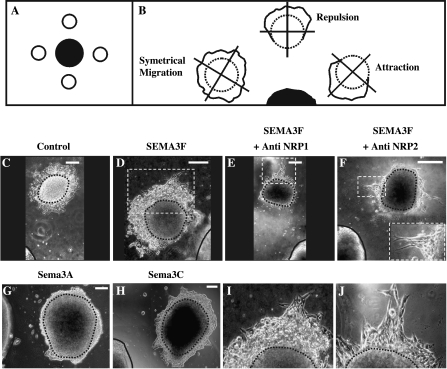Figure 1.
SEMA3F had a repulsive effect on C100 cells that involved NRP2 receptor. Tumor cell aggregates (A and B, white circle) were arranged all around control or semaphorin-secreting HEK 293 aggregates (A, black circle; B, black semicircle) in a three-dimensional plasma clot. Three major tumor cell migration types could be observed after a 3-day incubation: a symmetrical migration (B, left drawing), a repulsion (B, top central drawing), or an attraction (B, right drawing). C100 cell aggregates were placed in front of HEK 293 aggregates transfected with AP construct (C, control), AP-SEMA3F (D–F), Sema3A (G), or Sema3C (H). In some cases, C100 cells were treated during 3 days with anti-NRP1 (E) or anti-NRP2 (F) antibodies. (I) and (J) are a higher magnifications of the dashed squares represented in (D) and (E), respectively, showing C100 cells escaping from the more distal parts of the aggregates from the SEMA3F source. C100 aggregates are represented by a black dashed line (B–J) and are surrounded by C100 migrating cells. Secreting HEK 293 aggregates are delimited by a black drawing (C–H). In (F), an inset of escaping cells is shown at the bottom right. C100 aggregates are entirely represented, but only a part delimited by the black drawing is shown for secreting HEK 293 aggregates (C–H). Scale bar = 200 µm.

